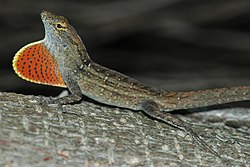Brown anole: Difference between revisions
Undid revision 199682519 by 76.124.32.16 (talk) |
|||
| Line 26: | Line 26: | ||
==Behavior== |
==Behavior== |
||
Unlike the green anole which prefers foliage, the brown anole often scampers around on the ground. They are athletic creatures that run surprisingly fast, and jump many times their length. They can also climb straight up almost any surface at blinding speed. The brown anole gets used to humans and can often be studied at close range. |
Unlike the green anole which prefers foliage, the brown anole often scampers around on the ground. They are athletic creatures that run surprisingly fast, and jump many times their length. They can also climb straight up almost any surface at blinding speed. The brown anole gets used to humans and can often be studied at close range. |
||
omg wtf your a liar |
|||
==Molting== |
==Molting== |
||
Revision as of 21:30, 20 March 2008
| Brown Anole | |
|---|---|

| |
| Scientific classification | |
| Kingdom: | |
| Phylum: | |
| Class: | |
| Order: | |
| Family: | |
| Genus: | |
| Species: | A. sagrei
|
| Binomial name | |
| Anolis sagrei Cocteau in Duméril and Bibron, 1837
| |
The Brown Anole, Anolis sagrei (or Norops sagrei) also called the Bahaman Anole is a lizard native to Cuba and the Bahamas. It has been widely introduced elsewhere, and may now be found in Florida and as far north as Southern Georgia, Texas, Taiwan, Hawaii, and other Caribbean islands. Its introduction in the USA has altered the behavior and potentially triggered a negative effect on populations of the native Green Anole, Anolis carolinensis, also called the Carolina Anole. This is one of many other anole species and has a truly fascinating description and behaviour.
Description
The Brown Anole (also called Bahaman Anole in many pet stores) is a slender lizard reaching about 18 cm in length. Males and females differ somewhat in coloration: males have a dark stripe down their backs, females a light stripe. The mature males weigh about twice that of females. As in other anoles, the male has a brightly colored throat fan, called a dewlap, which is yellow or reddish-orange. They are territorial and the dewlap is used in territorial displays. Anoles have expanded toe pads that allow them to cling to smooth surfaces.

Behavior
Unlike the green anole which prefers foliage, the brown anole often scampers around on the ground. They are athletic creatures that run surprisingly fast, and jump many times their length. They can also climb straight up almost any surface at blinding speed. The brown anole gets used to humans and can often be studied at close range.
Molting
Both the brown anole and the green anole molt (shed). But unlike a snake, they do not shed in one piece but in flakes, some quite large. The molting anole grooms itself for about 25 minuts and then eats the flakes.
Tank Mates
Brown anoles are compatible with green anoles and long tailed lizards, though no more than one male should be in one terrarium. Brown anoles can also be compatible with Fire Bellied Toads, green tree frogs, and small geckos. Its best not to mix species due to parasites and illneses.
Food
The brown anole feeds on insects such as crickets, grasshoppers, roaches, spiders, mealworms, waxworms, it may eat others lizards ( green anole) if they are small enough and green anole eggs . They will also usually eat their molted skin.

